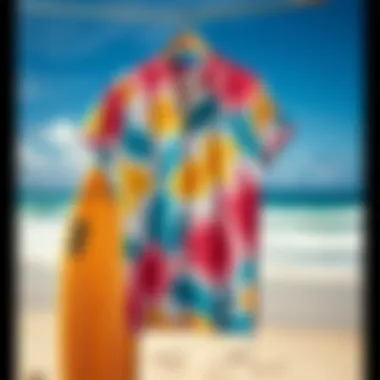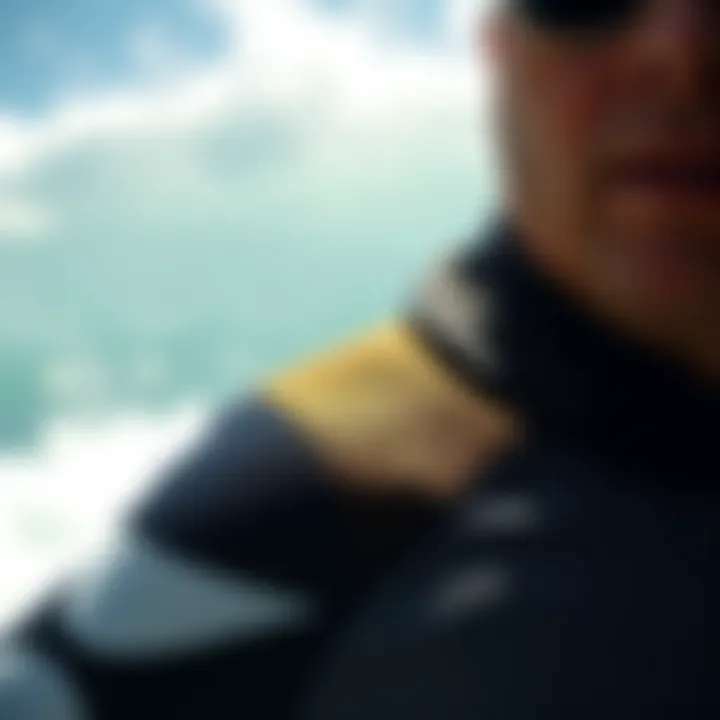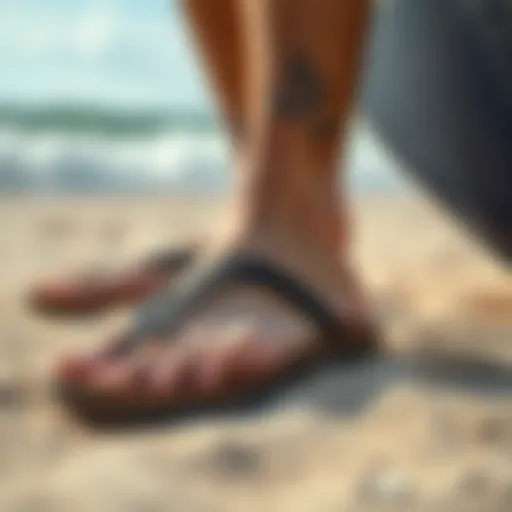Exploring Australian Surf Clothing Brands: A Deep Dive


Intro
The Australian surf culture is not just a hobby; it’s a way of life for many. From sun-kissed beaches to the roar of crashing waves, surfing thrives in the hearts of those who embrace the ocean’s pulse. Among the aspects that define this culture are the clothing brands that dot the coastline, each with their own story. This exploration takes us past mere fabrics and stitches, dissecting how these brands resonate with the oceanic lifestyle, commitment to sustainability, and their unique styles that echo across the globe.
The surf clothing landscape in Australia is rich and varied, reflective of the diverse influences that shape it. Local brands like Billabong and Quiksilver are more than just names; they’re symbols of a lifestyle infused with passion for surfing. However, it goes beyond the commercial. Sustainability is becoming increasingly important. Consumers now look for brands that not only offer trendy clothing but also align with eco-friendly practices. Riding the waves of change, these brands are stepping up, demonstrating a dedication to preserving the natural playground they thrive in.
As we journey through this article, we’ll dive into the narratives of notable Australian surf brands. We’ll unwrap their journeys from local garage startups to global players, each contending with changing consumer preferences and innovative designs. We’ll also touch on how local creativity impacts global trends, revealing connections that go beyond borders.
The discussion encompasses:
- The roots of select surf brands and their evolution
- The emphasis on sustainable practices within the industry
- Unique design styles and how they connect with surf culture
- Noteworthy brands that have made a significant mark
- Regional influences shaping these apparel trends
- Consumer preferences and environmental considerations
Ultimately, this exploration aims to offer comprehensive insights into not just what you wear while catching waves, but how those choices reflect broader cultural and environmental narratives.
Intro to Australian Surf Clothing Brands
Australian surf clothing brands are not simply names on a label; they embody the essence of a vibrant surf culture that thrives along the nation's picturesque coastlines. The connection between surfers and their apparel goes beyond fashion; it's about identity, passion, and functionality. Surfing in Australia is almost a rite of passage. It shapes social interactions and influences lifestyle choices, making the local brands crucial players in this narrative.
Why does the topic of Australian surf clothing brands matter? First off, these brands serve as cultural ambassadors of the sport, reflecting the uniqueness of Australia’s surf culture. They represent how the waves and wind inspire creativity, often culminating in innovative designs that not only look good but perform well in the water.
Local brands source materials from the environment around them, which often leads to eco-friendly practices. Surprisingly, many have pioneered sustainable approaches long before it became a trend. This commitment not only benefits the surfers but also contributes positively to the environment, resonating deeply with the growing number of environmentally conscious individuals.
Furthermore, the range of styles and designs from these brands highlight the diversity of surf culture—from casual beach attire to high-performance wetsuits. Each piece of clothing tells a story, whether it's crafted for the salty sea or a beachside barbecue.
Key Aspects to Consider:
- Cultural Impact: Explore how surf brands capture and reflect the lifestyle of Australian surfers.
- Innovation and Styles: Look at the fusion of style and technology that enhances the surfing experience.
- Sustainability Efforts: Investigate ongoing efforts by local brands to produce environmentally friendly clothing.
- Community Connection: Understand the significance of these brands within local surf communities.
“When you wear a piece from an Australian surf clothing brand, you’re not just wearing clothing; you’re wearing a piece of surf culture.”
In summary, discussing Australian surf clothing brands provides insights into a fascinating world where surf culture meets creativity, innovation, and sustainability. This article aims to peel back the layers of this influential sector, celebrating both its past and its potential, while connecting with those who live for the thrill of catching waves.
Historical Context of Surf Culture in Australia
The historical backdrop of surf culture in Australia is as pivotal as the waves themselves. This context lays the foundation for understanding not only the sportsman's thrill found in surfing but also a broader sense of identity tied deeply to these sun-soaked shores. Surf culture has roots that go well beyond just riding waves; it represents a lifestyle, values, and a unified community that spans generations, bringing both nostalgic elements and contemporary innovations under one broad umbrella.
Origins of Surfing in Australia
Surfing in Australia can trace its initial waves back to the 1900s, greatly influenced by the Hawaiian culture. Early accounts suggest that in the late 1800s, surfboard-like craft arrived on the Australian coast, captivating local beachgoers. In fact, the first documented surfboard riding happened at Bondi Beach in 1915, giving rise to a culture that would soon define Australian beach life.
As World War I settled in, many young men returned from combat with a desire for freedom – and nothing epitomized this connection to nature more than surfing. The 1950s marked the boom of surf culture, buoyed by a surge in domestically produced boards and vibrant beach communities emerging along the coasts. Today, surfing is more than just a sport in Australia; it has become intertwined with the nation's identity, a universal language spoken among sunburnt locals and tourists alike.
Evolution of Surf Apparel
The evolution of surf apparel mirrors the transformation of the culture itself, shifting from primitive designs to fashion statements that resonate with both surfers and non-surfers. Originally, surfers donned whatever was available—often cotton shorts or old school wool swimsuits, which were hardly suited for the rigors of riding waves.
By the 1960s, however, brands such as Rip Curl and Billabong started emerging, refining not just the function of surfwear but also its aesthetic appeal. Bright colors, bold patterns, and functional materials began to replace the muted tones and fabrics of previous decades. Today, neoprene materials and high-performance fabrics have revolutionized surf attire, offering protection from the elements while maintaining style.
The drive for versatile apparel continues to lead innovations in surf clothing, intertwining advanced technologies such as UV protection and quick-dry capabilities into everyday wear. This evolution highlights how surf clothing has transcended its sporting roots, becoming a symbol of lifestyle, passion, and commitment to the ocean.
"Surfing isn’t just a sport; it's a way of life. The history of what we wear while riding those waves reflects who we are as a community."
In sum, the historical context of surf culture in Australia reveals a rich tapestry woven from the fabric of the nation's beaches, people, and changing times. From humble beginnings to global recognition, surfing has etched itself into the Australian way of life, with its apparel constantly adapting to meet the needs of both functioning in the water and thriving on the beach.
Significance of Local Brands
In the realm of surf clothing, local brands in Australia hold immense significance. They are not merely retailers with waves and palm trees splashed on the fabric; they embody the spirit of the surf culture that is deeply woven into the fabric of Australian identity. When delving into the sustained existence of these brands, one can appreciate how they serve as a bridge between the coastlines and the local communities, nurturing a sense of belonging among surfers of all levels.
Cultural Representation
Local surf clothing brands act as ambassadors of Australian surf culture. They channel the essence of the local lifestyle into the apparel they produce, effectively showcasing the distinctive style of Australian surf life. From cutting-edge boardshorts that reflect the vibrant beach scene to graphic tees depicting iconic surf spots, these pieces often tell a story.
- Connection to Elements: Designs frequently incorporate motifs inspired by the waves, coastal flora, and even specific surf breaks that hold significance to local communities. This creates a sense of pride among customers who wear these brands, knowing they are representing something larger than themselves.
- Cultural Narratives: By producing clothing that reflects local experiences, these brands help strengthen the narratives of cultures that might otherwise get lost in globalization. For example, a brand might feature imagery that highlights significant historical events in Australian surfing, or styles that have roots in indigenous patterns and symbols.


Community Engagement
The connection between local surf brands and their communities runs deeper than just style. Many of these companies engage in various activities that support local interests and foster community ties.
- Supporting Events: Countless brands sponsor local surf competitions, workshops, or charity events. This involvement not only promotes the brand but also uplifts the local surf scene, providing platforms for aspiring surfers to showcase their talents.
- Collaboration with Local Artists: Collaborative efforts often materialize, with surf brands partnering up with local artists for unique collections. These efforts help bring awareness to different facets of the community and provide artists a new outlet to express their creativity.
In essence, local Australian surf brands exemplify cultural representation and community engagement, offering more than just clothing but also reinforcing networks of support. By purchasing from these brands, surfers are not just donning a product; they are expressing allegiance to a whole way of life, reflecting their connection to the waves and those who share their passion.
"Wearing local surf brands is like carrying a piece of home, wherever you go."
By buying into these philosophies, consumers help sustain a local industry that thrives on passion, expertise, and a true love for the surf culture. This also encourages sustainability practices, as many local brands are beginning to incorporate eco-friendly materials into their clothing lines.
Sustainability in Surf Clothing
Sustainability in surf clothing has become a blazing topic over the past years. As environmental concerns grow, more surfers and outdoor enthusiasts are questioning the impact of their gear on the planet. The surf industry is not just about riding waves; it's also about protecting the oceans and coastlines we love. With climate change and pollution increasingly hitting home, brands are stepping up to ensure they aren't just contributing to the problem but rather being a part of the solution.
The shift toward sustainable surf clothing is significant for several reasons. First, it aligns well with the core values of surfing culture, which is deeply rooted in respect for nature and environmental stewardship. Surfers tend to have a unique connection with the ocean, making them more aware of the consequences of their purchases. Wearing sustainably produced clothing serves not only to represent personal choices but also reinforces communal values, creating awareness and promoting a cleaner planet.
Material Innovations
The backbone of sustainability in surf clothing is found in material innovations. Traditional surf apparel often relies on synthetic fabrics, which can take hundreds of years to decompose. Fortunately, brands are now leaning towards eco-friendly alternatives.
- Recycled PET: Many surf brands are opting for recycled plastic bottles to create their fabrics. This innovative approach not only reduces landfill waste but also conserves resources needed for virgin materials.
- Organic Cotton: Using organic cotton eliminates harmful pesticides and reduces water usage dramatically. It’s a win-win!
- Hemp and Bamboo: These materials are incredibly resilient and require less water compared to cotton. Furthermore, they possess natural anti-microbial properties, making them ideal for active wear.
These innovative materials have the potential to change the game, providing durability and comfort while being mindful of the environment. They appeal not just to eco-conscious consumers but also to those who appreciate the performance benefits of high-quality fabric.
Ethical Manufacturing Practices
If the materials are the heart of sustainability, the manufacturing practices are undoubtedly the soul. Ethical manufacturing is about ensuring fair labor practices, reducing carbon footprints, and maintaining transparency in production processes.
- Fair Trade Certification: Brands proudly displaying Fair Trade certifications support fair wages and safe working conditions for their workers. It's not just about profit; it's about redefining success in a way that respects human rights.
- Local Production: Some brands choose to manufacture closer to home, reducing transportation emissions and investing in local economies. This choice fosters community engagement and enhances accountability.
- Low-Impact Production: Many companies are adapting techniques that consume less water and energy. For instance, using natural dyes instead of synthetic ones minimizes chemical runoff, which is beneficial for ocean health.
"Sustainable surf clothing is not just about the fabric; it’s about the entire journey of the product from design to delivery. It's a collective effort!"
Through these ethical practices, brands can build trust with their customers, who increasingly value not just the aesthetics of surf clothing but also the integrity behind them.
Notable Australian Surf Clothing Brands
The Australian surf clothing scene isn't just about looking good while catching waves; it signifies a lifestyle tied to the ocean and a unique cultural identity. Each brand carries its story and echoes the spirit of the surf community, providing gear and apparel that resonates deeply with surfers and beachgoers alike. Notable brands serve as beacons of quality, style, and innovation, attracting those who understand that surf clothing is more than fabric—it's a connection to the sea and to each other.
Billabong
Founded in 1973, Billabong is a cornerstone of Australian surf culture. Known for its practical yet stylish designs, Billabong caters to a wide range of customers, from seasoned surfers to casual beachcombers. The brand's commitment to both function and fashion sets it apart. Its wetsuits and board shorts are crafted to withstand the rigors of surf life while ensuring comfort and flexibility. Billabong regularly collaborates with athletes to create garments that reflect the wearer's experiences.
"Billabong represents not just a brand but a culture that champions the ocean lifestyle".
Beyond apparel, the company is deeply involved in environmental efforts. Initiatives like their Eco-friendly range show how they blend modern fashion with sustainability, appealing to today’s eco-conscious consumer.
Rip Curl
Rip Curl, established in 1969, holds a prominent place in the surf industry. The brand is often acknowledged for its innovations in surf gear, particularly its wetsuits known for their flexibility and heat retention. During the cold winters, a good wetsuit is crucial for maintaining warmth in the water. Rip Curl's dedication to constant improvement has resulted in many technological advancements, like the "Flash Bomb" range, which continues to set benchmarks for performance.
The brand's slogan, "The Ultimate Surfing Company," embodies its ethos — focusing on the surfer's experience. They also host the World Surfing League, galvanizing their community while showcasing their commitment to the sport. Additionally, Rip Curl is continually exploring sustainable practices, ensuring their trajectory aligns with environmental welfare.
Quiksilver
Quiksilver made its mark in 1969 and rapidly became synonymous with surfing culture. Its vibrant designs are appealing not just for performance but also for aesthetics. Quiksilver also features a wide range, showcasing everything from high-performance rash guards to casual tees, catering to diverse preferences. It creates gear that emphasizes both individuality and a passion for surf culture.
Quiksilver is also dedicated to community involvement, from sponsoring events to supporting local surf schools. They often release limited-edition collections in collaboration with renowned artists, which forms a bridge between surfing and art, captivating a broader audience. With such offerings, Quiksilver highlights the appeal of surf culture beyond just water sports, establishing itself as an influential lifestyle brand.
Naked Raygun
Though relatively lesser-known than its predecessors, Naked Raygun challenges the traditional stance of surf apparel with unique designs and an emphasis on individuality. Established in the early 2000s, it targets surfers looking for a fresh and unabashedly authentic look. With its eye-catching graphics and bold colors, the brand appeals to a younger demographic that appreciates originality.
Naked Raygun takes pride in its grassroots approach, often supporting local artists and showcasing collaborative artworks in its lines. Their focus on authenticity aligns perfectly with a consumer base that craves genuine connections in a commercialized world. This commitment sets them apart, allowing them to cultivate a loyal following within the surfing community.


يوم Surfware
يوم Surfware embodies a blend of traditional surfing ethos with modern technological advancements. Established recently, it aims to redefine the surf clothing landscape by merging innovative materials with a fresh, culturally aware design perspective. Their offerings, from stylish boardshorts to comfortable casual wear, reflect a deep respect for the ocean and its surrounding landscapes.
The brand stands out for its commitment to ethical practices, ensuring that its production methods are sustainable and socially responsible. This focus resonates with many surfers who prioritize environmental stewardship alongside their passion for the sport. By promoting a lifestyle that marries sustainability and style, يوم Surfware aims to contribute positively to the surfing community and broader societal dialogue.
Regional Influences on Surf Apparel
When we think about surf clothing, we usually picture sun-soaked beaches and laid-back vibes. But there's a bit more going on below the surface. The regional influences that shape Australian surf apparel are dramatic and diverse, rooted deeply in local cultures and environmental conditions. Understanding these influences is crucial when examining how surf brands formulate their identities and offerings.
The surfing scene in Australia is traditional but also repeatedly evolving due to regional identities and styles. From the choices of colors to the types of materials used, each coastal area contributes its character to the broader Australian surf apparel landscape. This variety means surfers can express not just their love for the waves, but also their local pride through what they wear.
East Coast vs. West Coast Styles
The contrast between the East Coast and West Coast of Australia is more than just geographical; it extends to the very fabric of surf culture. On the East Coast, particularly in areas such as Byron Bay and the Gold Coast, the fashion tends to lean towards vibrant colors and bold patterns. Think bright prints on board shorts, tank tops with funky designs, and accessories that scream summer vibes. The atmosphere is lively, and that energy reflects in the apparel choices of its surfers.
Conversely, the West Coast, represented by places notoriously known for their rugged beauty like Margaret River, offers a colder and harsher environment which significantly influences its surf clothing. Here, styles often reflect more muted tones, with a focus on durability and practicality. Surfers might opt for thicker wetsuits given the colder waters, along with layers that are versatile for both surfing and casual wear. The unpretentious nature of the West Coast's dress reflects its more laid-back lifestyle.
Each coast has manifested its own style, creating a unique identity that promotes individuality among surfers.
In essence, while both coasts share a passion for the ocean, their distinctive environmental and cultural contexts foster very different styles,
Impact of Local Surf Communities
Local surf communities play an essential role in shaping surf apparel as well. These tight-knit groups often set trends based on their specific needs and preferences, which are influenced by the kind of waves in their area or a particular surf culture unique to that community.
For instance, in Margaret River, where the surf can be both powerful and unpredictable, surfers might prefer functional and unassuming gear that can withstand the rigors of demanding waves. Polling local surfers about their preferences can lead brands to delve into innovative, performance-based materials, ensuring that they provide gear that truly works for the users.
In contrast, communities in places like Bondi Beach may prioritize style over functionality, leading to a fashion-centric approach to surf apparel. Local events, surf competitions, and lifestyle festivals also provide forums for these communities to showcase their style while influencing brands. Independent surf labels often spring from these grassroots movements, providing a genuine reflection of surf culture straight from the shoreline.
Recognizing and promoting these community-oriented brands can help foster a wider appreciation for the unique influences that local surf communities have on the overall surf apparel industry.
Through this exploration, it becomes clear that regional influences not only shape the aesthetics of surf clothing but also foster connections between surfers and their communities. This understanding leads to a richer appreciation for the culture that surrounds surfing in Australia.
Fashion Trends in Surf Clothing
The landscape of surf clothing goes beyond just function; it weaves together culture, personal expression, and sustainability. In recent years, fashion trends have paralleled the evolving identities of its wearers—surfers, travelers, and outdoor enthusiasts who revel in a lifestyle that embraces freedom and adventure. Understanding the current fashion trends in surf clothing is not just about style. It’s about recognizing a movement.
As surfers embrace a broader spectrum of lifestyles, clothing brands have adapted. They cater to diverse preferences, from performance-driven attire to casual wear that resonates with beach culture. These trends impact not only sales but also how the global audience perceives Australian surf fashion.
Key elements of these fashion trends include bright, adventurous patterns, eco-conscious materials, and hybrid designs that blend streetwear with functional surf gear. Benefits of understanding these trends include making informed purchasing decisions and enhancing one's lifestyle while supporting brands that align with personal values.
Current Styles and Preferences
Today, surf clothing is marked by vibrant colors and unique designs that speak to both the wearer and environment. Popular styles showcase a blend of retro and modern influences, featuring board shorts with psychedelic prints and rashies sporting subtle, muted colors that are equally stylish and functional. This evolution can be observed in the rise of tie-dye patterns, pastel hues, and floral prints, appealing to a newer generation of surfers.
Preferences vary greatly among different demographics; while younger adults may lean towards loud designs and influences from streetwear, older generations often prefer classic silhouettes and muted styles. This shift signifies a changing appreciation for clothing that stands out yet also embodies the essential values of surf culture—unity, freedom, and connection with nature.
- Bright colors and intricate designs are becoming staples of surf wear.
- Retro styles are making a comeback, influencing modern designs.
- Diverse material choices allow for both comfort and durability.
Combination of Functionality and Fashion
Finding the perfect balance between functionality and fashion in surf clothing represents a significant trend within the industry. The demands of an active lifestyle call for attire that not only looks good but also performs well in various conditions. This has led to innovations in fabrics, such as moisture-wicking and quick-drying materials that provide comfort without sacrificing style.
A prime example is the use of recycled fabrics. Brands are sourcing materials like recycled polyester to create high-quality products that meet both performance criteria and sustainability goals. The surf community is increasingly leaning toward brands demonstrating a commitment to the environment, showing that a stylish appearance can be viable without harming the planet.
"The modern surfer cares just as much about the state of our oceans as they do about their gear."
In a sense, surf clothing has transcended mere garments; it is now a statement of identity. Consumers are more likely to support brands that not only deliver quality but also reflect their beliefs and lifestyle choices.
Consumers reflect a desire for products that successfully merge aesthetics with utility, showing that fashion trends in surf clothing are as dynamic and unique as the waves themselves.
- Innovative materials enhance both durability and comfort.
- Sustainable practices are a growing expectation among consumers.
- Fashion choices now often reflect personal and environmental values.
To understand the future landscape of surf apparel, one must keep an eye on emerging trends, preferences, and innovations that shape the surfwear industry.


Consumer Preferences and Behaviors
Understanding consumer preferences and behaviors is pivotal when exploring Australian surf clothing brands. Surfing culture isn’t just about riding the waves; it embodies a lifestyle, complete with unique fashions that resonate deeply with individuals. As surfers, travelers, and outdoor enthusiasts flock to brands that reflect their identity, the choices they make become critical cues for manufacturers and retailers alike. Knowing what drives these decisions can illuminate broader market trends and ultimately influence the success of a brand.
Analyzing Market Trends
In the world of surf apparel, trends fluctuate with the speed of ocean tides. Consumers are increasingly keen on sustainability, reflecting a broader societal shift toward eco-friendly products. Brands that are transparent about their material sourcing and production methods tend to attract attention. For example, a surf brand using recycled plastics or organic cotton, such as Patagonia, has garnered a loyal following among environmentally conscious surfers.
Moreover, regional styles also come into play when analyzing market trends. East Coast surfers may gravitate towards more vibrant prints and patterns, while those on the West Coast might prefer a more muted aesthetic, resembling the natural landscapes. This divergence encourages brands to tailor their offerings to meet the unique tastes of local populations.
Key trends to consider include:
- Sustainable materials: A push towards using recycled or organic materials.
- Collaborative designs: Partnerships with local artists to infuse community culture into apparel.
- Diversity in sizing: Catering to a wider range of body types, ensuring inclusivity in the surfing community.
Brand Loyalty among Surfers
Loyalty among surfers often runs deep, akin to a strong tide that reminds them of cherished experiences and connections. Many surfers remain loyal to brands that not only provide quality gear but also share values that resonate with them. This connection often stems from personal stories, achievements, or experiences associated with the brands. For instance, a surfer's first boardshorts from Rip Curl may create lasting memories, leading them to continue purchasing from the brand even when they have options.
Moreover, community engagement plays a vital role in fostering this loyalty. Brands that actively sponsor local events or engage in social causes resonate well with consumers who value social responsibility.
Elements influencing brand loyalty include:
- Trust in quality and performance.
- Emotional connection based on shared values or experiences.
- Active involvement in local communities and issues relevant to surfers.
"Purchasing surf clothing isn’t merely transactional; it’s an expression of identity and belonging."
Thus, as Australian surf clothing brands navigate an ocean of choices, understanding consumer preferences and behaviors is essential to stay afloat. The intertwining of sustainability, localized trends, and loyalty markers paints a vivid picture of where the surf clothing industry is heading. Keeping a keen eye on these dynamics can not only help in meeting consumer expectations but can also guide brands in fortifying their places within the competitive waves of the market.
The Future of Australian Surf Clothing Brands
As we look forward in the context of Australian surf clothing, it's clear that the intersection of culture and innovation is driving the conversation forward. Understanding the future of these brands is vital, not only for those immersed in surf culture but also for consumers who are conscious of their choices. The essence of surf clothing brands lies in their ability to adapt and respond to the ever-evolving landscapes of sustainability, style, and technology.
Adapting to consumers' expectations while staying true to a brand’s heritage creates significant challenges and opportunities. It's more than just survival; it’s about thriving in an increasingly competitive market. Establishing a foothold in this realm, brands must align their messaging with environmental consciousness, grasp the trends of the current generation, and incorporate technological advances into their apparel. These elements are becoming non-negotiable in an era where consumers value purpose over products.
Emerging Brands and Innovations
A surge of new players has entered the Australian surf clothing scene, bringing fresh ideas and approaches to the market. These emerging brands are trailblazing paths in sustainability and innovation, often inspired by grassroots movements and local surf cultures.
- Local Sourcing: New brands are focusing on locally sourced materials to minimize their carbon footprint. For example, companies like Aloha Surf Apparel are constructing clothing lines that highlight native materials, intertwining land and surf artistry.
- Upcycled Fashion: Upcycling is a trend that new surf brands are embracing, creatively repurposing waste into beautiful, functional clothing. Brands such as Tidal Threads utilize discarded fishing nets and ocean debris to create impactful pieces.
- Collaborative Collections: Many newcomers opt for collaborative collections with local artisans or communities, a model that not only fosters unity but offers authenticity in every piece.
Innovations in fabric technology are also playing a crucial role. Brands are experimenting with materials that promote not just aesthetic appeal but functional enhancements like UV protection, waterproofing, and breathability. The innovative spirit evident in these new arrivals suggests that the future may very well lie in smaller, agile brands that prioritize quality, sustainability, and community engagement.
Integration of Technology in Apparel Design
The integration of technology into surf apparel design represents a transformative frontier laden with possibilities. Brands are employing cutting-edge techniques to give surfers more control over their gear and comfort on the waves.
- Smart Fabrics: Innovations such as moisture-wicking materials and temperature-regulating fabrics are becoming more commonplace, enhancing performance on hot days or during chilly ocean breezes. Brands like SurfTech are already pushing the envelope here.
- Augmented Reality (AR): Some brands are beginning to use AR for virtual fit experiences, allowing customers to visualize how clothing will fit without trying them on physically. This could very well revolutionize the shopping experience, aiding in reducing returns and fostering satisfaction.
- Wearable Tech: There’s an exciting momentum building around wearable technology integrated into apparel, enabling surfers to track performance metrics directly from their clothing. Imagine surf suits that can analyze wave patterns or provide vital health data during sessions.
As the landscape of surf clothing continues to shift, concern for the environment is barely just the tip of the iceberg. Conclusively, the future of Australian surf clothing brands rests on their ability to innovate while fostering community connections and sustainability practices.
"The surf culture is in constant evolution; to stay relevant, these brands must be engaging and accountable to their audience while pushing boundaries in design."
With the rise of new ideas and technologies, it promises to be a rich era for both established and emerging brands alike, revealing pathways that the surfing community could not have imagined a decade ago.
For more insights into the evolving world of Australian surf culture, consider visiting Surf Resource or exploring discussions on platforms like Reddit.
Ending: The Lasting Legacy of Australian Surf Brands
As we draw this exploration to a close, it's essential to reflect on the enduring legacy of Australian surf brands and their significant contribution to both the surfing world and fashion landscape. These brands are not merely purveyors of clothing; they encapsulate a lifestyle, an ethos that resonates deeply with surfers, outdoor enthusiasts, and even those who may never set foot on a board.
Australian surf brands have carved out a unique identity through their deep-rooted connection to the Australian way of life. From the sun-drenched beaches of Bondi to the rugged coasts of Margaret River, the surf culture is interwoven with the nation’s cultural fabric. The significance of these brands can be broken down into several key elements.
- Cultural Impact: They provide a voice for Australian surf culture, showcasing the rugged beauty and adventurous spirit of the country. Brands like Billabong and Rip Curl have transcended clothing and become symbols of freedom and individuality.
- Innovation and Sustainability: With a growing emphasis on environmental responsibility, many brands are pushing the envelope in material innovation and ethical manufacturing. This evolution not only appeals to conscious consumers but also sets a precedent for future generations in the apparel industry.
- Community Anchor: These brands often engage with local surfing communities, supporting initiatives that promote surf culture and environmental conservation. By sponsoring events and collaborating with local artists, they foster a sense of belonging and pride.
"The best surf brands create more than just apparel; they craft communities and stories that surfers proudly wear on their backs."
- Global Reach: While rooted in Australian culture, the appeal of these brands extends far beyond. They serve as ambassadors of the surf lifestyle on a global stage, influencing trends in beachwear and casual fashion across continents.
In summary, the lasting legacy of Australian surf brands lies in their ability to blend style, functionality, and cultural heritage. These brands don’t just dress surfers; they embody a way of life that millions aspire to. By preserving authentic surf culture while embracing innovation, they ensure their relevance in an ever-changing fashion industry. The future looks bright for these brands as they continue to set trends and champion sustainability within the surf clothing arena.
As we wrap this corner of the surfing world, let us appreciate the brands that have made waves not just for their stylish threads, but for their integral role in crafting and sustaining the rich heritage of Australian surf culture.



